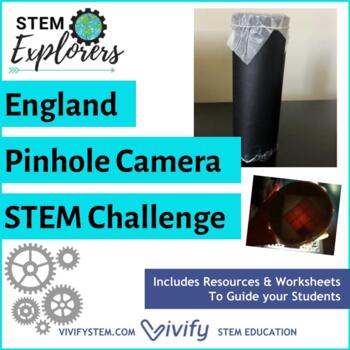England Pinhole Camera STEM Challenge (History + Engineering)
- PDF
Also included in
- STEM Explorers Bundle - Global Engineering ChallengesPack your bags and take your students on a voyage of STEM challenges that incorporate the engineering design process with themed activities from countries around the world. This STEM curriculum includes activities that travel to each continent andPrice $30.40Original Price $38.00Save $7.60
- Are you in need of year-round STEM activities? This growing bundle includes our most popular STEM lessons and engineering design challenges for elementary! Activities are adaptable for 1st through 5th grade with guidance provided in the teacher notes. Need help with a STEM Curriculum Map? Grab our FPrice $410.72Original Price $513.40Save $102.68
- Are you in need of year-round STEM activities? This growing bundle includes ALL Vivify K-12 STEM lessons from team challenges, engineering design, semester-long STEM units, research projects, and more! Purchase everything for 20% off individual products! Here is a sample of what is included: Stage 1Price $990.24Original Price $1237.80Save $247.56
Description
England STEM Challenge - Engineering Design with Digital Journals
Take your students on an educational journey to England with this STEM lesson! Read the letter from fictitious travel guides explaining the innovation of the light bulb in England which led to the use of light bulbs in homes and theaters. Students will learn about light refraction and camera obscure as the foundation of how optics work like our eyes and a camera. Then students will complete an engineering design challenge to build a pinhole camera to project an image on their pinhole image screen. Related math problems extend the learning fun!
As with many STEM activities that are student-driven, this challenge can be tailored to students of various skill levels and abilities.
Included in this product:
- Detailed teachers guide with links to resources
- Grading rubric for the engineering design process
- Editable digital and printed STEM journals in Google Slides for the engineering challenge
- History connection: Explore famous England landmarks
- Science connection: camera obscura
- Real-world connection: Invention of the light bulb
- STEM Career Connections: photographer and optical engineer
- Icebreaker activity instructions and activity handouts
- Student handouts to guide them through the engineering design process
- Math extension problems
Required Materials for Challenge:
- shoebox, or cardboard to build a box
- wax paper
- masking tape
- aluminum foil
- construction paper
- rubber bands
- craft sticks
- wooden clothespins
- toilet paper tubes
- card stock
- thumbtack to make pinhole
- dark room or blackout fabric
- bright light
Looking for more STEM lessons? Our team of engineers and educators is dedicated to developing low-prep and high-quality STEM activities for any classroom! Click below to learn more:
- Vivify's Scope & Sequence + Standards Alignment
- Vivify's Resource Guide
- Learn about the 3 Stages of STEM
- Vivify STEM Membership
Customer Tips:
• Click the Green ★ to follow our store and get notifications of new products and freebies
• Leave feedback to receive TpT credit for use on future purchases
• Questions? Contact us in the Product Q&A section
♥ Connect With Us ♥
Email us: info@vivifystem.com







